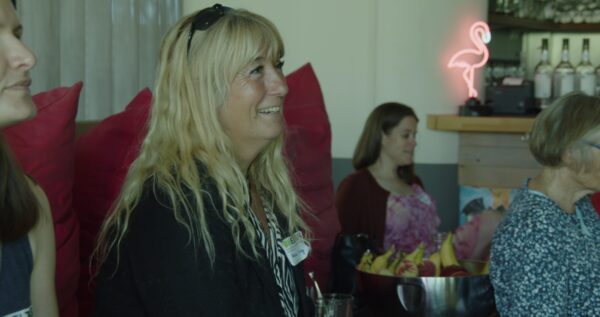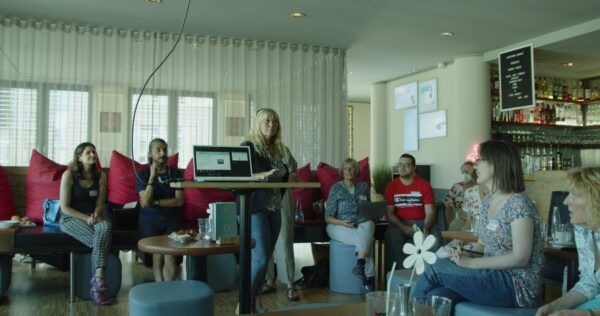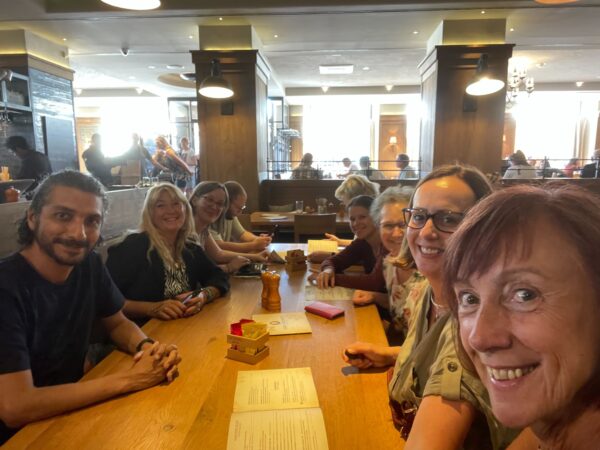 On July 16th, 30 Eltas members and visitors from other ELTAs around Germany came out to enjoy the sunshine in our summer event, a workshop with Rachel Paling on Neurolanguage. We started off with a brunch at California Bounge in Stuttgart. For some people it was the first face to face event in over a year, and so it was great to catch up over coffee and nibbles.
On July 16th, 30 Eltas members and visitors from other ELTAs around Germany came out to enjoy the sunshine in our summer event, a workshop with Rachel Paling on Neurolanguage. We started off with a brunch at California Bounge in Stuttgart. For some people it was the first face to face event in over a year, and so it was great to catch up over coffee and nibbles.
As well as language teaching, Rachel has degrees in law and neuroscience and is a PCC ICF Life Coach. She has used this background to create Neurolanguage Coaching ®, a method and approach which incorporates neuroscience and coaching principles and applies them to language learning. In this workshop we were treated to a crash course in this method. Unfortunately, there were some problems with the venue which meant that Rachel couldn’t use her slides, but this didn’t take anything away from the workshop, which I think everyone found useful.
The focus of the workshop was how to recognise and deal with various emotional triggers that language learners face, especially when studying grammar. These emotional triggers can arise from the teacher’s behaviour or the learners’ experience and attitudes towards English

Emotional Trigger: Teachers don’t really listen to what learners are saying
This is a really common human trait, not just among language teachers. Often when someone else is talking, we are actually thinking about our own experience of this topic or planning what we are going to say next. A solution to this is to reformulate what a learner is saying to us, for example with the phrase “So what I’m hearing is…” This both confirms to learners that you are actually listening and can also provide alternative language on the topic.
Emotional Trigger: Teachers finish off learners’ sentences
Often teachers jump in and finish students’ sentences because we think we are helping and, either consciously or unconsciously, we find silence uncomfortable. However, in reality this can be counterproductive. Students have different thinking times and the axiom “To learn it you have to do it” applies to language learning as well as many other skills. By not allowing learners to finish their sentence you are depriving them of valuable practice, as well as damaging their confidence. To counteract this teachers need to consciously let go and give learners time to think. This could even include an explicit agreement, for example if a learner can’t find language they will give you a sign to jump in, such as raising their hand.
Emotional Trigger: Questions
Although questions are essential in any interaction, they can also be problematic for several reasons. Open questions are better than closed questions because the latter can be leading and come across as judgemental (e.g. “Was that a good idea?” versus “What do you think about that idea?”). Personal questions can also be problematic. Questions beginning with ‘why’ can automatically lead to an emotional response (imagine asking a teenager “Why didn’t you clean your room?”). Rachel instead suggested questions such as “What is the reason for that?”, which tend to elicit a more rational, reasonable response.

Emotional Trigger: Fight or Flight
Rachel also talked about certain situations which can trigger a ‘fight or flight’ response, for example having to answer the phone in English. This arises from a part of the brain called the amygdala, which causes a full body response, with blood pumping away from the rational logical areas of the brain – something that Rachel referred to as the “low road”. This makes sense from an evolutionary point of view, when early humans had to be ready to flee from predators, but is less useful in the modern world. What we need to do instead is to train the brain to take the ‘high road’. But how can we do this?
Rachel suggested several techniques, such as signposting throughout a lesson. This gives students a roadmap so that there are no surprises for them, providing a space of psychological safety to practise in the classroom.
Above all, it is important to express empathy, recognition and compassion when learners are struggling emotionally. This can be expressed by phrases such as “I’m sorry you feel this way”, “I understand that this is difficult”, and “What can I do to make this better for you?”.
On the other hand, one of the most important positive emotions which we can foster in the classroom is curiosity, which in turn leads to the release of dopamine, the brain’s reward chemical.
Summary
Throughout the workshop Rachel stressed the importance of allowing learners autonomy to make decisions themselves and simultaneously providing them with scaffolding, for example creating connections by discussing the similarity and differences between the target language and the learners’ native language. There were many opportunities to work in groups and practise the techniques that Rachel was talking about, culminating in us trying our hand at teaching our partners a grammatical structure in a foreign language that we know but they don’t (my partners had a go at learning basic word structure in Japanese).

After the workshop a group of us headed over to Carl’s Brauhaus for dinner which was a great way to end the day. Thank you to Rachel and the ELTAS committee for all your work to make it a success.


No Comments Yet